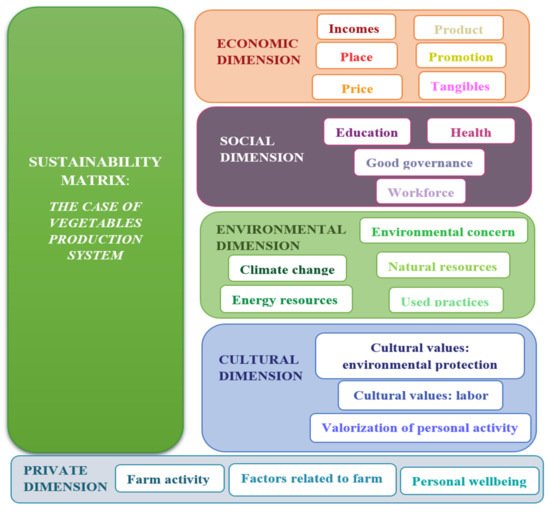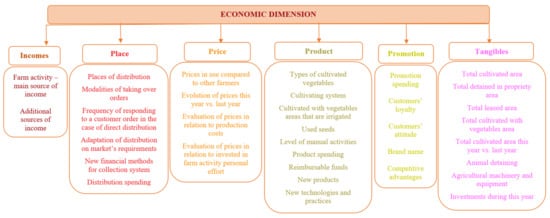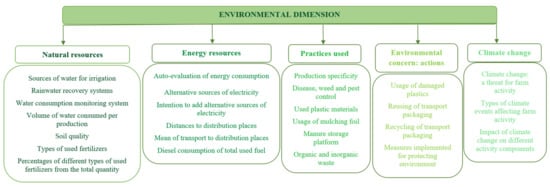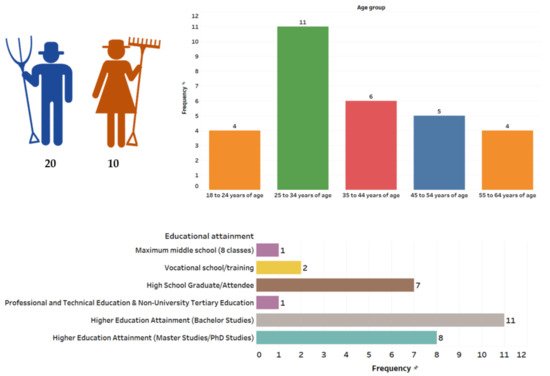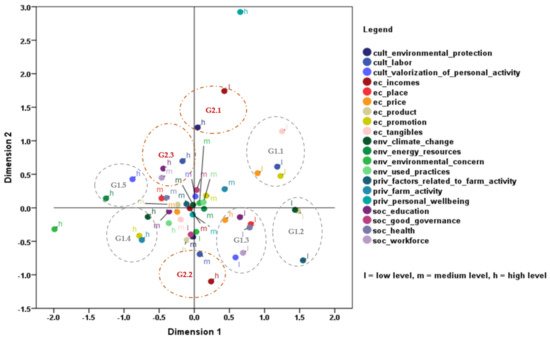1. Introduction
Sustainability represents one of the main concerns for the agricultural domain [1,2], related to the idea of sustainable agriculture [3] as a way of achieving some of the sustainable development goals [4]. Closely related to this, food sustainability is one of the concepts considered important to achieving global sustainable development, potentially improving the efficiency and sustainability of resource use, while simultaneously reducing natural resource damage and waste.
Local food supplies are generally considered more sustainable because they take into account all three dimensions of sustainability, while producing economic benefits, generating environmental positive effects, and creating a favorable social impact [5]. In addition, many studies found that consumers often perceive local foods as more sustainable than non-local foods. Still, (1) local foods are not necessarily more environmentally sustainable [6]; (2) social impacts are also highly relevant, because consumers prefer local foods to support regional farms [7,8]; (3) sustainability has become an arena of competition among companies. In the food sector, a diffuse perception of the unsustainability of “big food” [9,10] has opened the way to a myriad of “local food” initiatives. The “local” has been frequently associated with sustainable and healthy production and consumption patterns [11,12], allowing “weak” actors in the system—in particular, farmers—to challenge “big food” with alternative principles, values, organizational patterns, and business models [13,14].
In this context, some of the benefits of an organizational evaluation in terms of sustainability should be mentioned. At the company level, it may prove effective to explore best practices, benchmarks, critical points, and errors to avoid. At the consumer level, the comparative sustainability assessment can promote more informed choices, based on multiple criteria of economic, social, ethical, health, and environmental impact of food behavior. At the policy level, it can help better understand the synergies between configurations and the dynamics that integration may generate in relation to the desired policy goals. This type of assessment can assist decision-making and strategic planning throughout the entire policy cycle [15] (p. 4), [16] (p. 99). Comparative sustainable assessment could also be the basis for a “social contract” approach to corporate responsibility [14], as a possible way for providing a higher volume of public goods capable of increasing the total obtained income [17] (p. 275).
As an implication of the evolution in the development theory, a better understanding of the principal components of sustainable development in different areas of activity remains one of the major current issues, because, apparently, the principle of sustainable development is not sufficiently put into practice and also not sufficiently understood for a proper evaluation in different contexts. However, proponents of sustainable development differ in their perspectives on what is to be sustained, what is to be developed, and how to link the environment to the different dimensions of society [18] (p. 560). In this context, the definitional ambiguities concerning sustainable development are frequently mentioned [18,19,20,21,22], justifying the amount of work dedicated to developing quantitative indicators used for measurements (such as [1,23,24,25,26,27,28,29,30,31,32,33,34]).
Assessment of the sustainability of different farming systems is a challenging process including several steps, such as: identification of stakeholder groups, selection of experts, issues, and weights that illustrate the roughly similar influence of various aspects and sustainability dimensions [35,36,37]. In addition, the sector of agriculture is divided into different sub-sectors (as the one of vegetable production) characterized by specific features that, accordingly, require special attention. This extra element reveals the complexity of the evaluating process of agricultural sustainability and constitutes a premise for considering it of foremost significance for the authors of this paper.
A series of major arguments support the importance of measuring sustainability through developing a sustainability tool for the vegetable production system [19,31,32,33,38,39,40,41,42,43,44,45,46,47,48].
Firstly, sustainability represents a relative concept that fluctuates in terms of meaning, being determined by the evolution of a society as a whole. Moreover, as Gómez-Limón and Riesgo [31] (p. 3345) pointed out, moving on to a narrower area of analysis, that agricultural sustainability translates into “the ability of agricultural systems to satisfy different demands as times change”. Hence, it is underlined the constant need of updating this concept based on the changes registered at societal level and in specific areas of analysis, such as the production of vegetables, in this case. Accordingly, what sustainability means must be specific to time and place [31] (p. 3345), and yet also specific to the topical domain of application [33]. The fact that sustainability represents a relative concept was considered as one of its limits, hindering its usefulness as a criterion for guiding the development process in different areas of interest [31] (p. 3345). This limit may be avoided through continuous adaptation of its evaluation tools, while taking into consideration the major directions of change, such as: time, space, and domain of application.
Secondly, although the major scope of a food system is to produce food commodities based on economic reasons, the producers also need to consider the effects of the environmental and social dimensions of their activities along the entire product life cycle [32,38,39,40]. Based on this evaluation, the directions of proper actions that answer to the desideratum of sustainability might be possibly formulated.
Thirdly, there is always room for improving the analysis of the sustainability phenomenon, as “thanks to Walras, Pareto or Nash, we will be convinced there are no ideal models of sustainability” [19] (p. 25).
Fourthly, a new reconfiguration in terms of food and health security, as a consequence of the new context imposed by the actual sanitary crisis, can be noticed. People tend to register a higher awareness on the importance of health in their life [41,42] and, consequently, become more health-oriented in terms of food [42,43,44]. In some countries, due to the crisis triggered by the COVID-19 pandemic, people started to purchase more fresh vegetables and food, both directly and online, from local producers/processors [45,46]. In the light of our new actual sanitary context and along with the fact that sustainability, through its objectives, represents a major goal in itself, always striving for improvement and adaptation in constantly changing contexts that in their turn, ask for new ways of analysis and measurement, a novel approach could be recommended for appreciating the sustainability of vegetable production systems. Similar approaches have been proposed by Gómez-Limón and Riesgo [31], Talukder et al. [1], Iocola et al. [47], and De Olde [48]. Each of them tried to respond as properly as possible to their analyzed context, necessarily to be taken into consideration when proposing such a tool; still, their application remains limited and necessarily adaptable to new contexts, as a function of other specific proposed goals.
Consequently, the main aim of this study is to run a diagnostic on sustainability for the vegetable production system, with focus on the North-East Development Region of Romania. Thus, we are looking to attain a clear image of what sustainability could represent in this area, dividing its main features into four main dimensions (economic, social, environmental, and cultural), while adding the private dimension. Although the first three dimensions are the most commonly ones in the approaches regarding sustainability, the dimension related to the cultural aspect is also not exactly new, it has been already met in various studies, such as those of Horlings [49], Axelsson et al. [50], Chiu [51], Scerri and James [52], Al Shamsi et al. [33], Peano et al. [53], the main justification being that culture supports ways of actions almost throughout, whether if refers to work, co-operation, labor division, environmental attitudes, and so on. Further on, this study would like to discuss a new dimension, i.e., the private one, which we consider essential when, although “it is of the ensemble” [19] (p. 24), sustainability is put into practice by individual initiatives characterized by specific features that should not be neglected. Individualism, and not holism, as a principle of judgment, remains the distinctive feature of constructing and acceding to economic welfare [19] (p. 5), as the basis for the other dimensions of sustainability [27], without which neither social nor environmental dimensions could be supported in their process of attaining a sustainable path, their status representing “a consequence rather than a starting point” [19] (p. 24). Therefore, following Smith [54], the individual initiative is the main resort of bringing about transformation [19,55,56]. Consequently, our study firstly analyzes a specific type of this individual entrepreneurial initiative and, secondly, given the importance of the personal component in the development path of an individual initiative, also integrates among sustainability’s dimensions the private one, characterized by personal peculiarities capable of enriching the ability to comprehend the whole perspective upon a sustainable activity.
2. Methodology of Constructing a Sustainability Matrix for the Vegetable Production System
The conceptual framework for evaluating the level of sustainability in a vegetable production system, depending on its five dimensions, is shown in Figure 1. Each dimension contains different appropriate sub-dimensions which are further detailed in the next part of the methodology section. Accordingly, the five dimensions represent the basis of our sustainability matrix, a potentially effective tool for evaluating the sustainability of small vegetable farmers, as detailed below: (1) the economic dimension, with its specific features in terms of tangibles, product, price, promotion, distribution, incomes; (2) the social dimension, containing sub-dimensions, such as education, health, workforce, good governance; (3) the environmental dimension, analyzed from the perspective of natural resources, energy resources, used practices, environmental concern: actions, climate change; (4) the cultural dimension, with its specific components in terms of labor, valorization of personal activity, environmental concern, perceptions; (5) the private dimension, with focus on personal wellbeing, farm activity, factors related to farm. The sustainability matrix was built according to the main results shown in specific studies, considered relevant for our objectives. Thus, the most important arguments for selecting each dimension, sub-dimension, and particular components were explained with reference to the main findings provided by literature in the sections concerning the introduction (geared toward the dimensions) and methodology (with focus on sub-dimensions and their components), in order to support for our approach.
Figure 1. Sustainability matrix—dimensions and sub-dimensions.
2.1. Composition of the Sustainability Matrix—Economic Dimension
The economic dimension is composed of six sub-dimensions which include different specific components (Figure 2).
Figure 2. Sustainability matrix—Economic dimension and sub-dimensions.
Firstly, tangibles—such as the total cultivated area of land, total area held in property, total leased area, total area cultivated with vegetables, total cultivated area of the current year compared to the previous year, animal holding, agricultural machinery and equipment, investments of the current year—represent the material basis for the agricultural activities that directly influence the economic results and other components of sustainability, as well [
33]. The capital of the economic agents can be invested in goods with a utilization period longer than one year, defined as tangible assets, and representing the goods on which a real legal right can be exerted. They may include: freehold lands and land improvements, constructions, technical installations, machinery, machines or cars and furniture, advances given to the providers of tangible assets and tangible assets in progress [
57]. Agricultural business requires significant support for the processes of reproduction of the resource potential, the main place being held by the state of resources of enterprises, in particular, by fixed assets [
58] that need to be included in a matrix for evaluating the level of sustainability of a small vegetable farm.
Secondly, as part of the marketing mix (apart from price, place, promotion), as representing an important strategy consisting of different marketing tools used for selling on the market [
59], the generically-called product, in our economic dimension of sustainability, is related to the types of cultivated vegetables, cultivating systems, areas cultivated with vegetables (usually, an irrigated area), used seeds [
60], the level of manual activities, how products are capitalized, and also producers’ availability to integrate new technologies, to access new reimbursable funds, to diversify/extend the product portfolio of their vegetable production. All its components are known to significantly influence the economic dimension of the entire activity of the small vegetable farmers [
61,
62].
Thirdly, the price of vegetables provides an economic perspective on producers’ individual activity, which differentiates them on the market [
63], whereas its evolution, closely related to market fluctuations, outlines a real and pragmatic image of the economic dimension. Its role is extremely important, as widely highlighted in different studies and, as mentioned by Binswanger [
64] (p. 231), the literature shows convincingly that the long-run response of agriculture is quite ample: higher prices will slow migration out of rural areas and increased investment in agriculture. This is the second component of the marketing mix that makes the subject of our analysis in terms of active prices compared to other farmers, evolution of prices for the current year vs. previous year, evaluation of prices in relation to production costs and investments in farm activity and personal effort.
Fourthly, besides the issues related to product and price, producers should pay attention to all specific phases of taking a buying decision (problem recognition, information search, purchase, post-purchase evaluation) and thus run an effective promotional campaign for each stage and detail the strategic marketing plan without overlooking important elements of the buying decision process [
65,
66,
67]. Accordingly, the promotion of the small vegetable production represents an activity that implies specific actions, namely promotion expenses, customers’ loyalty, study of customers’ attitude [
68,
69], brand name, and the ability to benefit from competitive advantages. These components are integrated into the economic dimension for a proper evaluation of the sustainability of a vegetable farm.
Fifthly, the distribution (place) in the case of vegetables, given the specificity of the distribution chain in terms of adaptation to customers’ needs and requirements [
70,
71,
72], represents a synergy between the economic and environmental dimensions, especially when it comes to short food supply chains [
73]. Moreover, this requirement of adaptation has become more stringent in the current circumstances, as emphasized in different studies, such as those of Brumă et al. [
44] or Butu et al. [
45]. Consequently, for this sub-dimension, we have considered as fundamental the following aspects: places of distribution, systems of taking orders, frequency of replying to a customer order in the case of direct distribution, adaptation of distribution to market’s requirements, new financial methods for the collection system, distribution expenses.
Sixthly, incomes are a significant part of the economic dimension, closely linked to the possibility of putting into practice, at a satisfactory level, other dimensions of sustainability. Accordingly, on one hand, income ensures the financial basis for a sustainable activity [
74] and, on the other, it represents an important source of work satisfaction, able to create a synergy with the private dimension. In line with previous studies, the findings of Mayraz et al. [
75] confirm the importance of relative income comparisons to subjective well-being. In addition, the relative income (social as well as temporal) is more important for life satisfaction than the absolute income [
76]. With these assumptions in mind, the component of income for small vegetable producers is analyzed in terms of farm activity as their main source of income, besides other additional sources of income.
2.2. Composition of the Sustainability Matrix—Social Dimension
The social dimension is composed of four sub-dimensions, formed, in their turn, of different specific components (Figure 3).
Figure 3. Sustainability matrix—Social dimension and sub-dimensions.
Firstly, education, as one of the milestones of development, representing in itself an increasingly valued asset within all societies [
77], usually a must-have among the most important components of the social (human) wellbeing (see [
27,
78]) and with its main scope of forming and improving the competences of the labor force, is here analyzed from the perspective of the educationally qualified employees in agriculture, and in view of the educational contribution to the local development in the production activity.
Secondly, health is a component closely linked to the individual capabilities that, apart from the aspects regarding income and education [
79] (p. 9), is frequently included among the components of sustainability’s social dimension (see again [
27,
78]). The absence of health is connected to major negative issues, such as vulnerability, risk, powerlessness, lack of voice, and low environmental concern [
80]. Accordingly, in the here proposed sustainability matrix, health has been integrated among the four components of this dimension, being evaluated from the perspective of pesticide exposure, biodegradable transport packaging, and waste management plan.
Thirdly, workforce is an extremely important business asset, considered by Gómez-Limón and Riesgo [
31] as one of the most significant social indicators in the agricultural sector. In our work, it was included as a tool for measuring sustainability in terms of number of employees, comparison between the current year and previous year, local availability, and capacity of contributing to local development.
Good governance is on the list of the decisive points in the process of development [
81], showing positive changes in accordance with the six key principles [
82] (p. 138) referring to the following aspects: (1) voice and accountability of the citizens of a country; (2) political stability; (3) government effectiveness; (4) regulatory quality; (5) rule of law; (6) corruption [
27,
83]. In our sustainability matrix, it is evaluated from the perspective of bureaucracy in terms of its impact on farm activity, rule of law: respecting the legislative framework by most local producers and rule of law, applying sanctions considered essential for the type of activity analyzed in the present study in terms of frequency and local context (i.e., vegetable production).
2.3. Composition of the Sustainability Matrix—Environmental Dimension
The environmental dimension is composed of five sub-dimensions formed, in their turn, of different specific components (Figure 4).
Figure 4. Sustainability matrix—Environmental dimension and sub-dimensions.
Firstly, natural resources have been given considerable global attention in the literature, due to their broad economic implications [
1,
84,
85,
86,
87], while humans’ extensive consumption of them has been constantly exercising enormous environmental pressure [
88,
89]. Consequently, as an important component of the environmental dimension, in the present proposed matrix, sustainability of natural resources involved in the vegetable production is evaluated in terms of sources of water for irrigation, rainwater recovery systems, water consumption monitoring system, volume of water consumed [
31] per production, soil quality, types of fertilizers used, and percentages of different types of used fertilizers out of the total quantity.
Secondly, energy resources that pervade all sectors of society, from economics, labor, environment, international relations to personal lives regarding housing, food, health, etc. [
90], are therefore fundamental to social development [
91]. In this case (vegetable producers), they are observed from the perspective of auto-evaluation of energy consumption, alternative sources of electricity, intention of adding alternative sources of electricity, distances to distribution places, means of transport to distribution places, diesel consumption of total used fuel.
Thirdly, practices carried out in agricultural production are generally known as contributing to environmental pollution, which is further affecting food security, human health, and climate, thus imposing the need to shift from ‘unclean’ practices to sustainable ones [
92]. They are integrated into our environmental dimension of sustainability with focus on production specificity, disease, weed and pest control, used plastics, usage of mulch foil, manure storage platform, and organic and inorganic waste.
Fourthly, environmental concern represents a collocation usually met in the literature dedicated to environmental degradation [
65,
93,
94,
95,
96,
97,
98,
99,
100], having been acknowledged as one of the initial steps in the process of environmental protection, addressing changes in people’s behaviors [
101]. It can be analyzed from different points of view, such as usage of damaged plastics, transport packaging reuse and recycling, and measures taken for environmental protection.
Fifthly, climate change is the last component included in the suggested sustainability matrix for small vegetable producers, integrating perceptions on climate change as a threat for farm activity, types of climate events affecting farm activity, and impact of climate change on different activity components. As mentioned in FAO’s Work on Climate Change United Nations Climate Change Conference in 2016, climate change is profoundly impacting the conditions in which agricultural activities are conducted, no other sector being more sensitive to climate change than agriculture [
34] (p. 10). It is clearly explained that, in every region of the world, plants, animals, and ecosystems are adapted to the prevailing climatic conditions. When these conditions change, even moderately, plants and animals are impacted, some becoming less productive, or even disappear [
34] (p. 3).
2.4. Composition of the Sustainability Matrix—Cultural Dimension
2.5. Composition of the Sustainability Matrix—Private Dimension
4. Results
4.1. Descriptive Analysis
In terms of gender, our respondents are represented by 20 males and 10 females with ages ranging from 18 to 64 years. The largest group occurs in the 24–34 age range, representing 36.66% of the respondents. The age groups from the extremities (i.e., 18 to 24 years of age and 55 to 64 years of age) registered the same lowest frequency (13.33%). In terms of educational level, 63.33% of the respondents have higher education and 42.1% of them also have Master’s or PhD studies (Figure 7).
Figure 7. Main socio-demographic characteristics (age, gender, and educational attainment).
Considering the descriptive statistics regarding the variables used (Table 2) for measuring the components of the sustainability matrix, we can observe that, if at the general level of the five dimensions their values vary from 1 to 3, expressing the three levels of sustainability, the situation is different in the case of sub-dimensions.
Table 2. Descriptive statistics of the dimensions and sub-dimensions of the sustainability matrix.
For instance, in the economic and cultural sub-dimensions, all the three levels of sustainability were identified. On the contrary, in the social dimension, for the majority of sub-dimensions, respondents did not report a high level of sustainability. In addition, in many of the sub-dimensions corresponding to the environmental and private dimensions, the low level of sustainability was not identified among the respondents.
4.2. Multiple Correspondence Analysis (MCA)
MCA is a method of multivariate analysis that can be applied in the study of the associations between categorical variables. In the graphic plotted in Figure 8, the three levels of each variable were considered, namely low level—l, medium level—m, and high level—h, representing the sub-dimensions selected for evaluating each dimension of sustainability. Since the component of natural resources from the environmental dimension records zero variance, we excluded it from the MCA analysis. Each sub-dimension includes, in turn, several sub-components, as shown in the methodology section. Considering that our variables are categorical ones, we used the median value as the appropriate measure of central tendency, for establishing the specific level of each respondent regarding the analyzed sub-dimensions.
Figure 8. Associations among the sub-dimensions of the sustainability matrix.
For most of the sub-dimensions considered, the medium level appears in the center of the graphic representation, close to the intersection between the Ox axis (Dimension 1) and Oy axis (Dimension 2), showing insignificant associations between them (intersection points situated in the [0–0.5] interval). For the other two levels of the variables (i.e., low and high), we can observe various groups defined according to their position in the system of factorial axes (above 0.5 values on the axes).
Five groups were defined on Dimension 1, each represented by gray-colored circles (G1.1, G1.2, G1.3, G1.4, and G1.5) while, on Dimension 2, 3 groups (G2.1, G2.2, and G2.3) were identified, each represented by red-colored circles. Further on, we will present the components of each of these groups and the associations, in terms of sustainability, for small vegetable farmers (Table 2).
The graphical representation also shows that some of the groups are situated in different quadrants. In the case of Dimension 1, the elements of groups G1.1, G1.2, and G1.3 are positioned on the right side of the graph, while the elements of groups G1.4 and G1.5—on the left side. This means that negative associations exist between the first and the last groups. Regarding Dimension 2, the elements of groups G2.1 and G2.3 are positioned in the upper side of the graph, while those of group G2.2—in the lower side, meaning that it is negatively associated with the first two (see Figure 8 and Table 3).
Table 3. Associations among sub-dimensions of sustainability.
In summary, associations can be observed between the diverse components of the five dimensions of sustainability, which reveals their synergy, manifested in the activities performed by small vegetable farmers from the North-East Development Region of Romania. In other words, the significant role played by certain components of the different dimensions concerning the components from other dimensions in attaining sustainability is evidenced. Consequently, if producers’ goal is a sustainable activity, much attention should be paid to these types of links, which might prove decisive in obtaining high levels of sustainability.
Given that, as shown in Table 3, six components of economic dimension and six components of cultural dimension, along with two social, two environmental, and two private components are present in the associations among the analyzed sub-dimensions of sustainability, at least two possible conclusions may be drawn, namely: (1) the importance of different components of the other dimensions for the economic activity of small vegetable farmers, especially in terms of product, prices, place, promotion, tangibles, and income, in the context in which the economic dimension appears to be related to all the other dimensions, through different components, such as labor, farm activity and factors related to it, valorization of personal activity, workforce, education, health, climate change, and environmental protection; (2) the necessity of not overlooking the cultural background of a small vegetable farm, that is frequently associated with the components of the economic, social, and environmental dimensions, such as price, promotion, place, tangibles, incomes, workforce, health, education, and energy resources.
4.3. Descriptive Analysis of Different Types of Production Systems
This entry is adapted from the peer-reviewed paper 10.3390/su131810320
